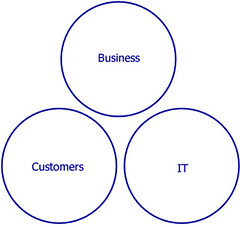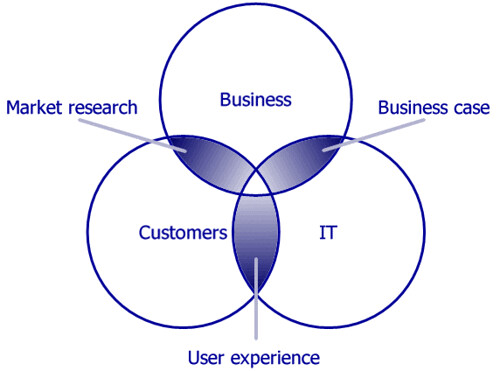Organisational convergence
Success is rarely delivered by one part of the organisation; it requires the collaboration of different departments working together. Yet there is all too often a separation of responsibilities that can hinder the efficient development of ideas. Worse, there is no single owner of the business case resulting in business value being lost.
A crude model illustrates this. The “business” holds the business case. They are focussed upon the benefits case. IT are treated a factory to build the mechanisms that will support proposition and are thus focussed upon the costs. The customers (who ultimately use the proposition) are held at arms length and not involved in the development of the proposition.

There can often be a tension between the business benefits case and the IT cost to deliver. The cynical view of the waterfall approach is that Business want it all, IT promise it all and their relationship deteriorates as the project nears its scheduled completion; IT cannot deliver on time or budget, the business has to make unplanned compromises and ultimately the customer suffers. The Agile approach goes some way to mitigating the risk of relationship breakdown. Painful messages about what can or cannot be delivered are communicated early on, enabling informed decisions to be made. However if the organisation is structured with clearly defined boundaries it is far harder to make truly informed decisions. As soon as scope changes, the business case will change. What often happens is that IT adjusts the numbers on the cost side, but the benefits case remains unchanged. If the business has spent many months working on the benefits case it is difficult to make changes on the back of an afternoon’s reprioritisation exercise. There is a solution to this. Taking an inclusive approach to proposition development and delivery; having all parties involved from the outset.
Here’s another crude model. Rather than being separated, the different stakeholders converge. There is a cross-pollination of ideas and understanding. The business case is shared, iteratively and incrementally developed. Customers are engaged in the process; providing market insight and testing the user experience. There is nothing new in this model, although I rarely see it working from the project outset. Often two of the three circles converge; the challenge is to get all three overlapping. I’m pleased to say at ThoughtWorks, increasingly when we initiate projects we are doing this.

Shouldn’t “Customers” be “Users”?